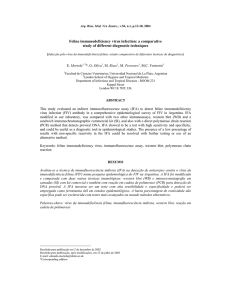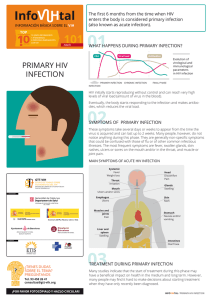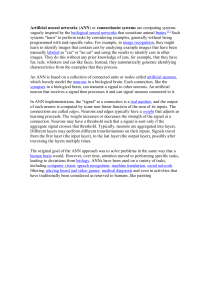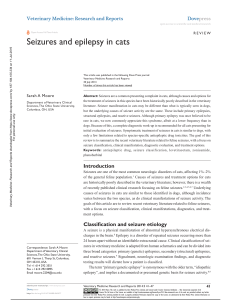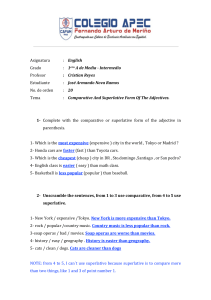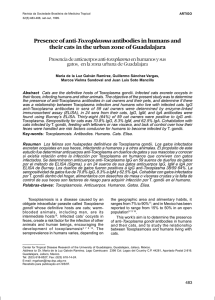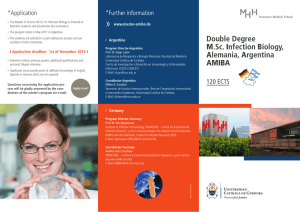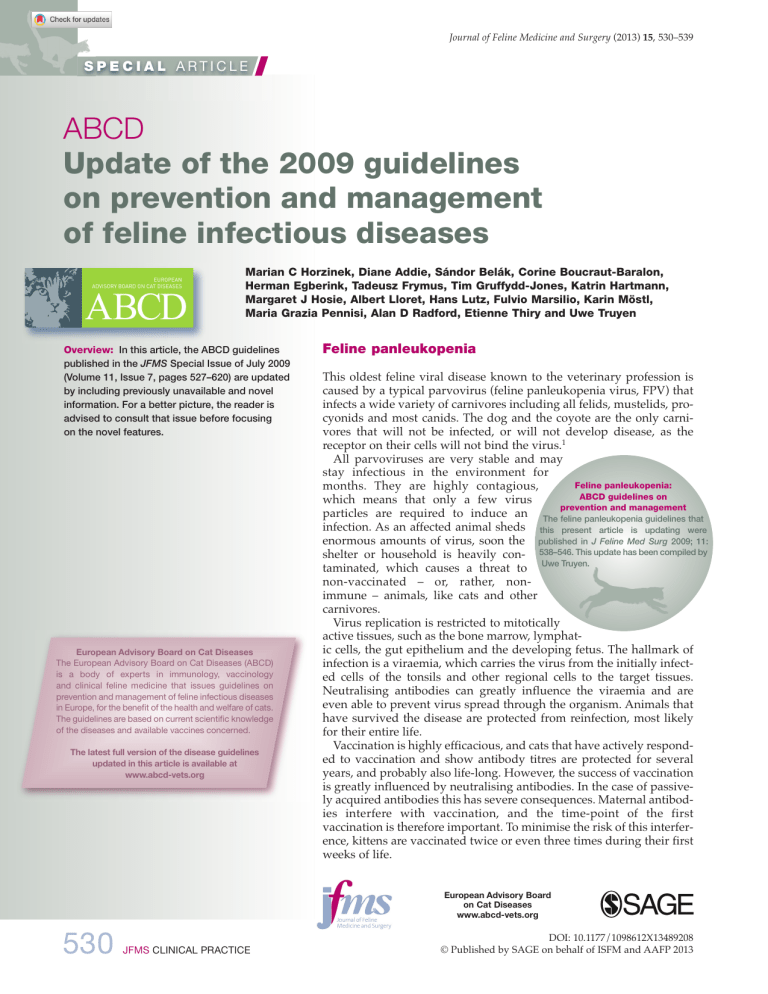
Journal of Feline Medicine and Surgery (2013) 15, 530–539 S P E C I A L ARTICLE ABCD Update of the 2009 guidelines on prevention and management of feline infectious diseases Marian C Horzinek, Diane Addie, Sándor Belák, Corine Boucraut-Baralon, Herman Egberink, Tadeusz Frymus, Tim Gruffydd-Jones, Katrin Hartmann, Margaret J Hosie, Albert Lloret, Hans Lutz, Fulvio Marsilio, Karin Möstl, Maria Grazia Pennisi, Alan D Radford, Etienne Thiry and Uwe Truyen Overview: In this article, the ABCD guidelines published in the JFMS Special Issue of July 2009 (Volume 11, Issue 7, pages 527–620) are updated by including previously unavailable and novel information. For a better picture, the reader is advised to consult that issue before focusing on the novel features. European Advisory Board on Cat Diseases The European Advisory Board on Cat Diseases (ABCD) is a body of experts in immunology, vaccinology and clinical feline medicine that issues guidelines on prevention and management of feline infectious diseases in Europe, for the benefit of the health and welfare of cats. The guidelines are based on current scientific knowledge of the diseases and available vaccines concerned. The latest full version of the disease guidelines updated in this article is available at www.abcd-vets.org Feline panleukopenia This oldest feline viral disease known to the veterinary profession is caused by a typical parvovirus (feline panleukopenia virus, FPV) that infects a wide variety of carnivores including all felids, mustelids, procyonids and most canids. The dog and the coyote are the only carnivores that will not be infected, or will not develop disease, as the receptor on their cells will not bind the virus.1 All parvoviruses are very stable and may stay infectious in the environment for Feline panleukopenia: months. They are highly contagious, ABCD guidelines on which means that only a few virus prevention and management particles are required to induce an The feline panleukopenia guidelines that infection. As an affected animal sheds this present article is updating were enormous amounts of virus, soon the published in J Feline Med Surg 2009; 11: shelter or household is heavily con- 538–546. This update has been compiled by taminated, which causes a threat to Uwe Truyen. non-vaccinated – or, rather, nonimmune – animals, like cats and other carnivores. Virus replication is restricted to mitotically active tissues, such as the bone marrow, lymphatic cells, the gut epithelium and the developing fetus. The hallmark of infection is a viraemia, which carries the virus from the initially infected cells of the tonsils and other regional cells to the target tissues. Neutralising antibodies can greatly influence the viraemia and are even able to prevent virus spread through the organism. Animals that have survived the disease are protected from reinfection, most likely for their entire life. Vaccination is highly efficacious, and cats that have actively responded to vaccination and show antibody titres are protected for several years, and probably also life-long. However, the success of vaccination is greatly influenced by neutralising antibodies. In the case of passively acquired antibodies this has severe consequences. Maternal antibodies interfere with vaccination, and the time-point of the first vaccination is therefore important. To minimise the risk of this interference, kittens are vaccinated twice or even three times during their first weeks of life. European Advisory Board on Cat Diseases www.abcd-vets.org 530 JFMS CLINICAL PRACTICE DOI: 10.1177/1098612X13489208 © Published by SAGE on behalf of ISFM and AAFP 2013 S P E C I A L A R T I C L E / ABCD guidelines update Primary vaccination course < A minimum of two doses – one at 8–9 weeks of age and a second 3–4 weeks later (at a minimum of 12 weeks of age) – should be administered to cats living in low-risk situations. < In higher-risk situations, a third vaccination, at 16 weeks, is recommended. Maternal antibodies may persist beyond week 12 in some cats, as field data suggest,2 such that vaccination at 12 weeks may fail to induce protection [EBM grade 1]. Therefore, a third vaccination at 16 weeks of life should be given, for example, to kittens in breeding catteries or cat shelters. This should also be considered for kittens born to queens with high antibody titres, as these may persist for more than 12 weeks (eg, kittens from queens that have recovered from the disease, that have lived in a high-exposure environment, or have received vaccination shortly before or during pregnancy). Systemic treatments Topical treatments Table 1 Feline herpesvirus infection Feline herpesvirus (FHV) is the agent of feline viral rhinotracheitis. Together with feline calicivirus and other pathogens, it is involved in the feline upper respiratory tract syndrome. Typical acute FHV disease results in rhinitis, conjunctivitis, and superficial and deep corneal ulcers, in particular dendritic ulcers. Latent chronic infection is the typical outcome of an acute infection, and reactivation gives rise to intermittent viral shedding in oronasal and conjunctival secretions. Feline herpesvirus Conjunctivitis may be associated infection: ABCD guidelines on with corneal ulcers, which may prevention and management develop into chronic sequestra. The feline herpesvirus infection guidelines FHV is the most important cause that this present article is updating were published in J Feline Med Surg 2009; 11: of corneal ulceration.3 Stromal 547–555. This update has been compiled by keratitis is a secondary, immuneEtienne Thiry. mediated reaction due to the presence of virus in the epithelium or stroma. Damage to the nasal Symptomatic treatment for acute respiratory disease Drug/treatment Rationale ABCD recommendation EBM grade Nasal flushing with physiological saline solution and nebulisation To clean nasal discharge and to prevent dehydration of the upper airways Recommended several times daily IV Highly palatable food To ensure sufficient food intake Necessary if cats do not eat because of pyrexia and/or ulcers in the oral cavity, or because of their loss of smell due to nasal congestion; food can be blended and warmed up to increase smell IV Placement of a feeding tube and enteral nutrition To ensure sufficient food intake Necessary if the cat has not been eating for 3 days IV Fluid therapy To control dehydration and restore electrolyte and acid–base imbalance Necessary in cats with severe clinical signs IV Antibiotics To control secondary bacterial infections Broad-spectrum antibiotics with good penetration into the respiratory tract are recommended for cats with severe disease IV Non-steroidal antiinflammatory drugs To decrease fever Recommended in cats that are severely depressed IV Drugs with mucolytic effects (eg, bromhexine) To improve mucous nasal discharge May be helpful IV Table 2 Symptomatic treatment for acute ocular disease (conjunctivitis and keratitis) Drug Rationale ABCD recommendation EBM grade Antibiotics To control secondary bacterial infections Topical antibiotics IV Anti-inflammatory drugs To decrease local inflammation Usually not needed; avoid corticosteroids IV JFMS CLINICAL PRACTICE 531 S P E C I A L A R T I C L E / ABCD guidelines update Antiviral drugs recommended for topical and systemic treatment of acute FHV ocular disease. The drugs are listed in decreasing order of preference Topical treatments Table 3 Drug Type of drug Route of administration and dose Efficacy in vitro Efficacy in vivo Controlled study in vivo? Comments EBM grade Trifluridine Nucleoside analogue Topical Use every h for 1st day and q4h thereafter7 Excellent ND No Topical treatment of choice for ocular FHV manifestations. Some cats averse to topical application. Toxic if given systemically7 III Cidofovir Nucleoside analogue 0.5% solution applied topically Yes Yes Yes Topical treatment for ocular FHV; potent drug with only two daily applications8,9 III Idoxuridine Nucleoside analogue Topical Use initially q2–4h7 Excellent ND No Topical treatment for III ocular FHV. Difficult to source; pharmacists can formulate a 0.1% ophthalmic solution. Toxic if given systemically Ganciclovir Nucleoside analogue Topical Excellent ND ND Topical treatment for ocular FHV. Good in vitro activity10 III Aciclovir Nucleoside analogue Topical and oral Poor (high doses may be needed to overcome viral resistance) Some Yes Least in vitro effect of all herpes antivirals10,11 Moderate in vivo effect.12 Synergy in combination with human IFN-α.13 Toxic if given systemically7,9 III Famciclovir Nucleoside analogue (prodrug) Oral, 90 mg/kg q8h for 21 days Yes (for penciclovir, as famciclovir is a prodrug of penciclovir) Yes Yes Tested in conventional III and SPF cat experimental challenge against primary infection14,15 Interferon Systemic: 1 MU/kg SC q24–48h Yes ND Yes Safe and licensed for use in cats Systemic treatments Feline IFN-ω Human IFN-α Interferon Oral: 50,000–100,000 Units daily A combined topical and oral pre-treatment before experimental FHV infection was not beneficial16 Topical: dilute 10 MU vial in 19 ml 0.9% NaCl and use as eye drops: two drops in each eye five times a day for 10 days17 Used along with L-lysine in chronic infections SC high dose Yes Yes Yes PO low dose Yes Yes Yes Amino acid 500 mg q12h, not added to food ND = not determined, SPF = specific pathogen-free 532 JFMS CLINICAL PRACTICE III 5–35 Units daily reduces clinical signs but not FHV shedding. Used along with L-lysine in chronic infections 5–35 Units daily L-lysine Less bioactive than feline interferon IV Yes Yes Yes No published evidence of II side effects, conflicting efficacy reports; can reduce spontaneous ocular viral shedding rates in latently infected cats experiencing reactivation; to be administered as separate bolus, not added to food4,7,9,18–22 S P E C I A L A R T I C L E / ABCD guidelines update turbinates during acute disease is a predisposing factor for chronic rhinitis. Molecular diagnosis is now in regular use, especially to identify FHV DNA in corneal samples. The practitioner should avoid the use of fluorescein and topical anaesthetics in the eye before sampling because these compounds can affect the sensitivity of some polymerase chain reaction (PCR) methods,4 unless permitted by the diagnostic laboratory. The symptomatic treatment for acute respiratory disease where FHV infection may be involved is summarised in Table 1. The symptomatic treatment for acute ocular disease is outlined in Table 2. Anti-herpesviral drugs have come to the market, which now allow recommendations to be made for the topical and systemic treatment of acute FHV ocular disease (Table 3). The drugs listed may not be readily available or licensed for cats. Other drugs have been proposed, like bromovinyldeoxyuridine, HPMA, ribavirin, valaciclovir, vidarabine, foscarnet and lactoferrin, but their efficacy has not been proven. Maternally derived (passive) immunity can interfere with the response to vaccination until about 8 weeks of age [EBM grade III];5 the primary vaccination course is therefore usually started at around 9 weeks of age, although some products are licensed for earlier use. Kittens should receive a second vaccination 2–4 weeks later, with the second given at around 12 weeks of age. Vaccination provides good protection against clinical signs, and also against viral shedding, within 1 week of administration [EBM grade III].6 FHV is common in multicat households, and infections can pose a problem in shelters. Management to limit the spread of infection is as important as vaccination. In shelters where incoming cats are mixed with resident cats, high infection rates are frequent. Newcomers should therefore be quarantined for the first 3 weeks, and kept individually – unless known to come from the same household. Feline calicivirus infection EBM ranking used in this ar ticle Evidence-based medicine (EBM) is a process of clinical decision-making that allows clinicians to find, appraise and integrate the current best evidence with individual clinical expertise, client wishes and patient needs. This article uses EBM ranking to grade the level of evidence of various statements and recommendations on a scale of I to IV as follows: < EBM grade I This is the best evidence, comprising data obtained from properly designed, randomised controlled clinical trials in the target species (in this context cats); < EBM grade II Data obtained from properly designed, randomised controlled studies in the target species with spontaneous disease in an experimental setting; < EBM grade III Data based on non-randomised clinical trials, multiple case series, other experimental studies, and dramatic results from uncontrolled studies; < EBM grade IV Expert opinion, case reports, studies in other species, pathophysiological justification. If no grade is specified, the EBM level is grade IV. Further reading Lloret A. The process of evidence-based medicine. J Feline Med Surg 2009; 11: 529. Roudebush P, Allen TA, Dodd CE and Novotny BJ. Application of evidence-based medicine to veterinary clinical nutrition. J Am Vet Med Assoc 2004; 224: 1765–1771. Feline calicivirus (FCV) remains an important cause of disease and a frequently diagnosed infection in both ill and healthy carrier aniFeline calicivirus mals. The virus evolves quickly and is infection: ABCD guidelines on very variable, particularly at antigenic prevention and management sites on its surface exposed to the The feline calicivirus infection guidelines feline immune response. As such, that this present article is updating were many strains co-circulate, even at the published in J Feline Med Surg 2009; 11: level of the population of cats seen by 556–564. This update has been compiled by a typical veterinary surgery.23 As well Alan D Radford. as causing consistent oral ulceration and upper respiratory disease, the virus has also been associated with superficial ocular disease.24 Nearly all cats with chronic lymphoplasmacytic gingivitis/stomatitis complex test positive for FCV. In addition, outbreaks of highly virulent and often lethal FCV infection in domestic cats have been described in the United States and in Europe; recently, a single outbreak has also been described in exotic captive felids in the USA. Transmission is usually through contact with infected cats but secretions can remain infectious in the environment for many days. Fleas that have lived on infected cats have also recently been shown to shed infectious faeces, although how significant this is in the field is unknown. Diagnosis is based on clinical signs, supplemented by virus isolation or PCR. Because of the frequent asymptomatic carrier phase, care should be taken when interpreting any FCV-positive result. Feline interferon-ω (licensed for the treatment of canine parvovirus and feline leukaemia virus infections in some European countries) has been shown to inhibit FCV replication in vitro. However, controlled field studies are lacking to support its use in cases of uncomplicated oral/respiratory disease. There is also some suggestion that strains of FCV may vary in their sensitivity to interferon. In cases of chronic stomatitis, topical oral interferon has been shown to lead to statistical improvement in clinical scores, but this improvement was generally not different from cats receiving steroid alone [EBM grade I].25 FCV vaccines provide protection mainly by inducing virus neutralising antibodies. As the virus can mutate quickly, field strains could JFMS CLINICAL PRACTICE 533 S P E C I A L A R T I C L E / ABCD guidelines update evolve resistance to any vaccine-induced immune response, particularly if a vaccine is used for a prolonged period of time in the population. Some laboratory studies lend support to this hypothesis [EBM grade III].26,27 Such studies are conducted to obtain more information about the strains circulating in Europe, and vaccine companies are seeking to identify newer strains that provide wider cross protection. However, the methodology used in such studies makes it difficult to draw any firm conclusions from these results. In addition, there are issues about how such laboratory studies relate to vaccine-induced immunity in the field situation. Field trials to show whether newer vaccine strains confer improved protection have not been undertaken. The most commonly used vaccine strains of FCV are F9, which is the oldest, isolated in the 1950s, FCV 255, and two new strains G1 and 431. Maternally derived antibody can interfere with vaccine-induced immunity. The higher the level, the greater the interference. Where a more rapid response to vaccination is required, a modified-live vaccine may be preferred [EBM grade III].28,29 The ABCD recommends that all kittens receive vaccinations at approximately 9 and 12 weeks of age, and for those individuals judged to live in high-risk situations, a further vaccination at 16 weeks. Dogs and cats in shelter or kennel environments should be housed separately, and flea control should be implemented to minimise the risk of transmission of FCV and other diseases. Point of care assays for identifying cats lacking protective immunity on admission to shelters have been described,30 but their practicality is not known. They should not be used as a replacement for rigorous biosecurity. Feline leukaemia D i a g n o s i s o f Fe LV i n fe c t i o n < The cat is positive for p27 This animal is viraemic. Cats with this result are always also PCR-positive for provirus. Viraemic cats should be kept separate from other cats. Given sufficient time, p27-positive cats can revert to a negative status if they remain healthy. < The cat is negative for p27 This animal has either never been in contact with FeLV or it has become immune. If it is immune, it might still be latently infected. Latent infection can be detected by showing proviral DNA using the PCR. Whether a PCR test should be done depends on the situation: a breeder with an FeLV-negative cattery who introduces a new breeding cat may want to be certain that this animal is not latently infected. < The cat gives a questionably positive test result for p27 This could mean that it has a focus of infection somewhere in the body, which releases low amounts of p27 into the circulation. Alternatively, the weak-positive result could be false. In this situation the test should be repeated after a few weeks, or a DNA PCR could be performed for confirmation. < Testing within a cattery To determine whether FeLV-viraemic cats are in a cattery, pooled saliva samples can be tested by RNA PCR. Saliva swabs from individual cats are put into tubes and shipped to the laboratory, where they will be extracted, pooled and assayed; cooling is not needed. The test is sensitive enough to detect a single infected cat in a pool of up to 30 samples.31 While all viraemic cats are positive for FeLV RNA in saliva, a few cats may be found that shed FeLV RNA in saliva but are not (yet) viraemic or antigenaemic.32 Note that these detection methods do not identify all FeLV-infected animals, possibly leading to an underestimation of the prevalence of infection. Lowdose exposure to the virus may result in seroconversion during a presumed abortive infection.33 Feline leukaemia virus (FeLV) is a gammaretrovirus of worldwide occurrence that is important for all small felids. Infected cats may become persistently viraemic and shed large amounts of virus through saliva and faeces, whereby they can infect other cats in close contact. Several variants of FeLV are known that differ in virulence and host cell spectrum. As is the case for all retroviruses, Feline leukaemia: a DNA copy of replicating FeLV RNA ABCD guidelines on is integrated into the DNA of host prevention and management cells (as so-called provirus), where The feline leukaemia guidelines that this it remains for the lifetime of the present article is updating were published in infected cell. J Feline Med Surg 2009; 11: 565–574. This Infection starts in the oro - update has been compiled by Hans Lutz. pharynx from where the virus will spread via leukocytes to lymph nodes and the bone marrow. Once the bone marrow is infected, viraemia will develop and, as a consequence, FeLV 534 JFMS CLINICAL PRACTICE replication will take place in many organs. In most cases, viraemia will be persistent and lead to clinical signs such as aplastic anaemia, immunosuppression and a variety of tumours. These cats are called progressor cats. In a fraction of infected cats, viraemia will either not develop or will be overcome after several weeks or months (regressor cats). Antibodies to FeLV and/or T lymphocytes are observed in regressor cats, suggesting that a functioning immune system is essential. Regressor cats remain latently infected for some time, and viraemia can be reactivated by stress and/or high doses of corticosteroids. The diagnosis of FeLV infection is mostly done by in-house tests that detect the viral core protein p27. Presence of p27 is a marker for infection and correlates well with viraemia. In addition, proviral DNA can be detected through PCR techniques in blood, and viral RNA, eg, in saliva. Information that can be drawn from test results is discussed in the box above. Treatment of viraemic cats can be tried using raltegravir, an antiretroviral drug used in AIDS treatment, at up to 40 mg/kg body weight per day. Under experimental conditions, a 15-week treatment regimen led to a strong decrease in S P E C I A L A R T I C L E / ABCD guidelines update viral loads; however, viraemia was not overcome completely [EBM grade III].34,35 Good (recombinant) FeLV vaccines are available, which protect from disease but not from infection. The ABCD suggests that cats at risk (eg, with access to outdoors) are primarily vaccinated. Cats living in an apartment with no contact with other cats may not need to be vaccinated. Vaccination should take place at 8–9 weeks, again at 12–13 weeks and 1 year later. Thereafter, vaccination frequency can be lowered to an interval of 2–3 years. Feline immunodeficiency virus infection Feline immunodeficiency virus (FIV) infection may induce clinical signs of immunodeficiency that lead to opporFeline immunodeficiency: tunistic infections or lymphomas, ABCD guidelines on prevention and management although in some cats the clinical signs are mild. A few studies have The feline immunodeficiency guidelines shown that the survival time of that this present article is updating were published in J Feline Med Surg 2009; 11: infected cats was not decreased; 575–584. This update has been compiled by such variable outcomes are likely a Margaret J Hosie. result of the heterogeneity of viral isolates as well as management practices. FIV-infected cats kept in single cat households with regular veterinary care are more likely to remain healthy than those in multicat households lacking regular health checks. Prompt supportive treatment dramatically increases the survival time for FIV-infected cats. The infection is usually diagnosed using inhouse serological assays to detect antibodies against major viral proteins, and it is important that such results are properly interpreted. Situations where a confirmatory test should be used are described in the box below. Several laboratories offer PCR tests for the diagnosis of FIV but these tests are not necessarily more reliable than serological tests. PCR Te s t i n g fo r F I V i n fe c t i o n A confirmatory test for FIV infection is required in the following situations: < In populations of cats of low FIV prevalence A positive result in a young indoor cat may be a false positive, and should be confirmed using a different test (eg, Western blot or virus isolation). < Kittens Young kittens may test seropositive owing to the persistence of maternally derived antibody and should be retested at 6 months to confirm whether they are infected. < Early stages of infection Seroconversion may be delayed for several weeks to months following infection, especially in cats homed together with FIV-infected cats. < Terminal stages of infection In cats with immunodeficiency and high viral burdens, antibody may be sequestered in virus–antibody complexes, leading to false-negative results. tests are highly prone to contamination and must be conducted under rigorous conditions with appropriate controls to minimise falsepositive results. False-negative results may arise in situations where the primers are not homologous to the infecting field strain and, therefore, infection is not detected. Few antiviral drugs are effective against FIV and do not induce adverse side effects. Treatment with nucleoside analogues that inhibit the reverse transcriptase, such as AZT or PMEA, may reduce clinical signs but these drugs, as well as derivatives such as PMPDAP, induce anaemia. Bicyclams bind to the FIV co-receptor molecule CXCR4, thereby inhibiting viral replication. Treatment with the bicyclam AMD3100 leads to a significant decrease in proviral load in cats naturally infected with FIV and may be a useful therapy, but this treatment should not be combined with PMEA [EBM grade I].36 A whole inactivated virus vaccine has been available commercially to veterinarians in the USA since 2002, and in Australia and New Zealand since 2004. However, its use is not recommended in Europe by the ABCD since the antibodies induced interfere with the serological diagnosis of infection. Also, the vaccine has not proven effective against primary field strains of FIV circulating in Europe. Feline rabies Rabies is still endemic in some middle and east European countries, and in 2011 the total number of animal cases in Europe was 5801, mainly involving foxes (source WHO). However, on very rare occasions isolated rabies cases in companion animals appear also in western European countries that are considered as rabies free. Often the source of these is illegal importation of a pet from endemic areas. Due to testing of pets for neutralising antibodies, which has been required by some countries before entering their territory, interesting data have been published about duration of the antibody response after vaccination. Though differences in efficacy between some commercial rabies vaccines used in Europe have been demonstrated,37–39 following a single vaccination these products have been shown to induce in most animals a titre above 0.5 IU/ml, the internationally accepted threshold antibody level [EBM grade III].37,38,40 In cats and dogs, the peak of rabies neutralising antibodies is generally reached 4–8 weeks after the first immunisation [EBM grade III].38 Nevertheless, the titre decreases with time. When tested 6–12 months after the first vaccination, about 8% of cats have a titre below 0.5 IU/ml [EBM grade III].39 In an JFMS CLINICAL PRACTICE 535 S P E C I A L A R T I C L E / ABCD guidelines update another study involving thousands of Most cats with FIP had no detectable intesdogs tested 120–360 days post-vaccinatinal FCoV and had seemingly cleared the prition, the proportion of animals with a mary infection. In those with detectable Feline rabies: ABCD guidelines on titre below 0.5 IU/ml was 12.6%, or intestinal FCoV, the virus always had an intact prevention and management 3.1%, depending on the vaccine 3c and seemed to have been acquired by FCoV The feline rabies guidelines that this brand used [EBM grade III].37 superinfection.43 Apparently, 3c-inactivated present article is updating were published in viruses replicate not at all – or only poorly – in There is increasing evidence that J Feline Med Surg 2009; 11: 585–593. the gut, explaining the rare incidence of FIP the persistence of antibody after This update has been compiled by Tadeusz outbreaks. After experimental infection with the first rabies vaccination may be Frymus. FIPV strains with an intact 3c gene, the virus much shorter than generally was shed in the faeces. Also, faecal virus from believed, especially in dogs. It has these cats was not infectious for other cats.44 been demonstrated that antibody titres fall below 0.5 IU/ml in almost 21% of Sequencing of many different FIPV and dogs within 4–6 months after a single vacciFCoV strains revealed two alternative codons nation [EBM grade III],40 and in many puppies in the S gene that correlated with the FIP phenotype in >95% of cases. This again supports it happens as early as after 56 or even 28 days the internal mutation theory and might also [EBM grade III].38 In another study the proporbe a basis for identifying the virulent FIPV tion of dogs with titres below 0.5 IU/ml phenotype in cats suspected of having FIP.45 6 months after the first vaccination reached 30% and then stabilised at above 30% during the next 6 months [EBM grade III].39 Thus, a Chlamydophila felis infection new regimen for rabies vaccination, consisting of double primary vaccination with a short Chlamydophila felis is primarily an ocular interval of 7–10 days and a 1-year booster, has pathogen, causing both acute and chronic been postulated.39 This procedure reduced the conjunctivitis. Serological surveys have shown proportion of cats developing a titre below that infection is widespread in cats but 0.5 IU/ml to almost zero, when tested within 6 most clinical cases occur in young cats under months, and in dogs this proportion was also 9 months of age, particularly pedigree significantly lower than in animals given a sinkittens from multicat households. gle primary vaccination [EBM grade III].39 Conjunctivitis is a common reason for Chlamydophila felis infection: ABCD guidelines on presentation of cats to practitioners A non-adjuvanted recombinant rabies vacprevention and management and Chlamydophila is the single most cine for cats was recently marketed in some The Chlamydophila felis infection common infectious cause and posEuropean and other countries. It has been guidelines that this present article is sibly the most common cause overshown to induce immunity lasting 3 years updating were published in J Feline Med Surg 2009; 11: 605–609. This update has all. The conjunctivitis is usually [EBM grade I].41 During efficacy studies it has been compiled by Tim Gruffydd-Jones. bilateral but may be unilateral early been observed that even two cats with a titre in infection or in chronic cases. at the time of challenge below 0.5 IU/ml Chlamydophila will not usually cause survived without developing rabies, suggestcorneal lesions. ing that mechanisms other than induction of PCR testing of ocular swabs is now the antibody play a role in protection.41 preferred method of diagnosis. Care is necessary in collecting swabs as the organism is Feline infectious peritonitis essentially intracellular and some conjunctival cellular material is required to optimise the The pathogenesis and epidemiology of feline chance of detecting the organism. infectious peritonitis (FIP), a bone of contention While other antibiotics, such as fluorountil recently, have been further elucidated. quinolones, have some activity against The hypothesis of mutants arising in individChlamydophila, systemic doxycycline (10 ual cats upon bursts of replication (eg, under mg/kg q24h) is regarded as the treatment of immune-suppressive stress) has been experichoice [EBM grade III] and should be continmentally corroborated and explains the ued for a minimum of 3 weeks to ensure that sporadic, non-epidemic occurrence of Feline infectious the infection is eliminated and signs do not FIP.42 Functional expression of one of peritonitis: ABCD guidelines recur when treatment is stopped. Local ocular the non-structural proteins (3c) is on prevention and management preparations to relieve ocular inflammation crucial for feline coronavirus (FCoV) The feline infectious peritonitis guidelines may also be beneficial. replication in the gut, but dispensa- that this present article is updating were Both inactivated and modified-live vaccines ble for systemic replication of the published in J Feline Med Surg 2009; 11: are available to assist in control. These are feline infectious peritonitis virus 594–604. This update has been compiled by only available as part of multivalent vaccines. (FIPV) mutant. While intact in all Herman Egberink. Both types of vaccines will prevent or reduce FCoVs, the 3c gene was found the severity of clinical signs but do not premutated in >70% of FIPV strains – but vent infection. These are not always included not in all, implying that mutation in 3c in routine vaccination programmes for pet is not the (single) cause of FIP. 536 JFMS CLINICAL PRACTICE S P E C I A L A R T I C L E / ABCD guidelines update cats but may be particularly indicated in catteries with endemic infection or in high-risk (most frequently multicat) situations such as breeding catteries and rescue shelters. Chlamydial polymorphic membrane proteins have been identified as immunodominant and considered as potential serodiagnostic antigens and novel vaccine candidates.46 Bordetella bronchiseptica infection in cats centration in the environment. An intranasal modified-live vaccine is available but not considered a core vaccine. Vaccination should be limited to cats living in high-risk environments such as shelters and boarding catteries, and where B bronchiseptica has been identified as the problem. The modified-live vaccine is licensed for use as a single vaccination with annual boosters. Interestingly, vaccination with an intranasal live FCV and FHV vaccine also reduced the signs of an experimental B bronchiseptica infection [EBM grade III].50 Whether this non-specific effect is also beneficial for protection under field conditions is unknown. Bordetella bronchiseptica is primarily a respiratory pathogen. The bacterium may particularly play a role in multicat environments, where other factors like overcrowding, stress and Influenza A virus infection in cats poor hygienic conditions exist. In general, clinical signs are mild, although pneumonia Felids can be naturally and experimentally has been reported, especially in young kittens infected with influenza A viruses; outcomes less than 10 weeks old. range from subclinical infection to fatal disB bronchiseptica is shed with oral and nasal ease. The virulence of H5N1 highly pathogensecretions of infected cats. After experimental ic avian virus strains for the domestic cat was infection, B bronchiseptica could be isolated for established at the very beginning of the 19 weeks after infection. Transmission is avian flu epidemics in Asia. During the through direct contact, although indirect same period, infection of household H5N1 avian influenza in transmission cannot be excluded. However, cats and outbreaks of fatal disease in cats: ABCD guidelines on B bronchiseptica is susceptible to common distigers and leopards were reported prevention and management The H5N1 avian influenza in cats infectants. Epidemiological studies suggest from Thailand. Then, in Europe, guidelines that this present article is that dog-to-cat transmission occurs. Also, a three cats were found dead on the updating were published in J Feline Med few reports describe cats as a possible source island of Rügen, Germany. The Surg 2009; 11: 615–618. This update has of infection of immunocompromised human susceptibility of the cat to influenbeen compiled by Etienne Thiry. patients. It is therefore justified to consider za A viruses was confirmed during B bronchiseptica as a rare but potential zoonotic the H1N1 pandemic in 2009/2010; infection.47,48 indeed, several cases of respiratory disease in domestic cats were linked to For a diagnosis of B bronchiseptica infection, the pandemic H1N1 virus.51 Luckily neiboth bacterial culture and PCR are available. B bronchiseptica can be isolated from orophather H5N1 nor H1N1 virus infections spread ryngeal or nasal secretions; alternatively, among domestic cats in Europe.52,53 transtracheal wash/bronchoalveolar lavage Cats can be infected via the intratracheal are used. Nasal swabs were shown to be more and oral routes and, for H5N1 virus, by feedoften positive then oropharyngeal swabs.49 ing them infected chickens. Infection with the H5N1 virus may occur through contact with Both methods lack sensitivity. infected birds, and with H1N1 likely with Antibacterial therapy is indicated, including infected owners. Therefore, a cat living in a in cases with mild clinical signs, to prevent household with human cases of influenza is at more severe disease due to colonisation of the risk. To date, no cat-to-person transmission lower respiratory tract. The choice of antibiotic has been reported, but the risk for persons can should be based on antibiotic sensitivity testing. presently not be predicted. If not available, tetracyclines, and in particular If influenza in cats is suspected, their case doxycycline, are the antibiotics of choice. histories need to be recorded. Differential Resistance has been detected against diagnosis should exclude other infections clavulanate-potentiated amoxicillin, Bordetella bronchiseptica infection leading to similar systemic and respiratory and to a higher extent against ampiin cats: ABCD guidelines on signs, including infections with FHV, FCV and cillin and trimethoprim [EBM grade prevention and management B bronchiseptica. Diagnosis should always be III]. Supportive therapy and intense The Bordetella bronchiseptica infection in confirmed by laboratory testing. In the nursing care are required in severe- cats guidelines that this present article is absence of specific preventive measures, the ly affected animals. updating were published in J Feline Med risk of a cat acquiring an influenza A virus The control of B bronchiseptica Surg 2009; 11: 610–614. This update has infection must be minimised through infections requires similar measures been compiled by Herman Egberink. management measures. Especially for H1N1, as used for other respiratory but also for other human influenza A virus pathogens (ie, FCV and FHV). These infections, patients must be advised to avoid are aimed at preventing spread of the physical contact with cats. infectious agents and reducing their conJFMS CLINICAL PRACTICE 537 S P E C I A L A R T I C L E / ABCD guidelines update Funding The authors received no specific grant from any funding agency in the public, commercial or not-for-profit sectors for the preparation of this article. The ABCD is supported by Merial, but is a scientifically independent body. Conflict of interest The authors do not have any potential conflicts of interest to declare. References 1 Kaelber JT, Demogines A, Harbison CE, Allison AB, Goodman LB, Ortega AN, et al. Evolutionary reconstructions of the transferrin receptor of Caniforms supports canine parvovirus being a re-emerged and not a novel pathogen in dogs. PLoS Pathog 2012; 8: e1002666. Epub 3 May 2012. DOI: 10.1371/journal.ppat.1002666. Jakel V, Cussler K, Hanschmann KM, Truyen U, König M, Kamphuis E, et al. Vaccination against feline panleukopenia: implications from a field study in kittens. BMC Vet Res 2012; 8: 62. Feline panleukopenia 2 3 Hartley C. Aetiology of corneal ulcers. Assume FHV-1 unless proven otherwise. J Feline Med Surg 2010; 12: 24–35. Gould D. Feline herpesvirus-1. Ocular manifestations, diagnosis and treatment options. J Feline Med Surg 2011; 13: 333–346. Poulet H. Alternative early life vaccination programs for companion animals. J Comp Pathol 2007; 137: S67–S71. Jas D, Aeberle C, Lacombe V, Guiot AL and Poulet H. Onset of immunity in kittens after vaccination with a non-adjuvanted vaccine against feline panleucopenia, feline calicivirus and feline herpesvirus. Vet J 2009; 182: 86–93. Maggs DJ. Update on the diagnosis and management of feline herpesvirus-1 infection. In: August JR (ed). Consultations in feline internal medicine. Volume 4, Philadelphia: WB Saunders, 2001, pp 51–61. Fontenelle JP, Powell CC, Veir JK, Radecki SV and Lappin MR. Effect of topical ophthalmic application of cidofovir on experimentally induced primary ocular feline herpesvirus-1 infection in cats. Am J Vet Res 2008; 69: 289–293. Maggs DJ. Antiviral therapy for feline herpesvirus infections. Vet Clin North Am Small Anim Pract 2010; 40: 1055–1062. Van der Meulen K, Garre B, Croubels S and Nauwynck H. In vitro comparison of antiviral drugs against feline herpesvirus 1. BMC Vet Res 2006; 26: 13. Williams DL, Fitzmaurice T, Lay L, Forster K, Hefford J, Budge C, et al. Efficacy of antiviral agents in feline herpetic keratitis: results of an in vitro study. Curr Eye Res 2004; 29: 215–218. Williams DL, Robinson JC, Lay E and Field H. Efficacy of topical aciclovir for the treatment of feline herpetic keratitis: results of a prospective clinical trial and data from in vitro investigations. Vet Rec 2005: 157: 254–257. Weiss RC. Synergistic antiviral activities of acyclovir and recombinant human leukocyte (alpha) interferon on feline herpesvirus replication. Am J Vet Res 1989; 50: 1672–1677. Malik R, Lessels NS, Webb S, Meek M, Graham PG, Vitale C, Feline herpesvirus infection 4 5 6 7 8 9 10 11 12 13 14 538 JFMS CLINICAL PRACTICE 15 16 17 18 19 20 21 22 et al. Treatment of feline herpesvirus-1 associated disease in cats with famciclovir and related drugs. J Feline Med Surg 2009; 11: 40–48. Thomasy SM, Lim CC, Reilly CM, Kass PH, Lappin MR and Maggs DG. Evaluation of orally administered famciclovir in cats experimentally infected with feline herpesvirus type-1. Am J Vet Res 2011; 72: 85–95. Haid C, Kaps S, Gönczi E, Hässig M, Metzler A, Spiess BM, et al. Pretreatment with feline interferon omega and the course of subsequent infection with feline herpesvirus in cats. Vet Ophthalmol 2007; 10: 278–284. Jongh O. A cat with herpetic keratitis (primary stage of infection) treated with feline omega interferon. In: Karine de Mari (ed). Veterinary interferon handbook. Carros: Virbac, 2004, pp 138–147. Maggs DJ, Nasisse MP and Kass PH. Efficacy of oral supplementation with L-lysine in cats latently infected with feline herpesvirus. Am J Vet Res 2003; 64: 37–42. Maggs DJ, Sykes JE, Clarke HE, Yoo SH, Kass PH, Lappin MR, et al. Effects of dietary lysine supplementation in cats with enzootic upper respiratory disease. J Feline Med Surg 2007; 9: 97–108. Stiles J, Townsend WM, Rogers QR and Krohne SG. Effect of oral administration of L-lysine on conjunctivitis caused by feline herpesvirus in cats. Am J Vet Res 2002; 63: 99–103. Rees TM and Lubinski JL. Oral supplementation with Llysine did not prevent upper respiratory infection in a shelter population of cats. J Feline Med Surg 2008; 10: 510–513. Drazenovich TL, Fascetti AJ, Westermeyer HD, Sykes JE, Bannasch MJ, Kass PH, et al. Effects of dietary lysine supplementation on upper respiratory and ocular disease and detection of infectious organisms in cats within an animal shelter. Am J Vet Res 2009; 70: 1391–1400. 23 Coyne KP, Christley RM, Pybus O, Dawson S, Gaskell RM and Radford AD. Large scale spatial and temporal genetic diversity of feline calicivirus. J Virol 2012; 86: 11356–11367. 24 Gerriets W, Joy N, Huebner-Guthardt J and Eule JC. Feline calicivirus: a neglected cause of feline ocular surface infections? Vet Ophthalmol 2012; 15: 172–179. 25 Hennet PR, Camy GA, McGahie DM and Albouy MV. Comparative efficacy of a recombinant feline interferon omega in refractory cases of calicivirus-positive cats with caudal stomatitis: a randomised, multi-centre, controlled, double-blind study in 39 cats. J Feline Med Surg 2011; 13: 577–587. 26 Lauritzen A, Jarrett O and Sabara M. Serological analysis of feline calicivirus isolates from the United States and United Kingdom. Vet Microbiol 1997; 56: 55–63. 27 Addie D, Poulet H, Golder MC, McDonald M, Brunet S, Thibault JC, et al. Ability of antibodies to two new caliciviral vaccine strains to neutralise feline calicivirus isolates from the UK. Vet Rec 2008; 163: 355–357. 28 DiGangi BA, Levy JK, Griffin B, Reese MJ, Dingman PA, Tucker SJ and Dubovi EJ. Effects of maternally-derived antibodies on serologic responses to vaccination in kittens. J Feline Med Surg 2012; 14: 118–123. 29 Lappin MR. Feline panleukopenia virus, feline herpesvirus-1 and feline calicivirus antibody responses in seronegative specific pathogen-free kittens after parenteral administration Feline calicivirus infection S P E C I A L A R T I C L E / ABCD guidelines update of an inactivated FVRCP. J Feline Med Surg 2012; 14: 161–164. 30 DiGangi BA, Gray LK, Levy JK, Dubovi EJ and Tucker SJ. Detection of protective antibody titers against feline panleukopenia virus, feline herpesvirus-1, and feline calicivirus in shelter cats using a point-of-care ELISA. J Feline Med Surg 2012; 13: 912–918. 31 Gomes-Keller MA, Tandon R, Gonczi E, Meli ML, HofmannLehmann R and Lutz H. Shedding of feline leukemia virus RNA in saliva is a consistent feature in viraemic cats. Vet Microbiol 2006; 112: 11–21. 32 Cattori V, Tandon R, Riond B, Pepin AC, Lutz H and Hofmann-Lehmann R. The kinetics of feline leukaemia virus shedding in experimentally infected cats are associated with infection outcome. Vet Microbiol 2009; 133: 292–296. 33 Major A, Cattori V, Boenzli E, Riond B, Ossent P, Meli ML, et al. Exposure of cats to low doses of FeLV: seroconversion as the sole parameter of infection. Vet Res 2010; 41: 17. 34 Cattori V, Weibel B and Lutz H. Inhibition of feline leukemia virus replication by the integrase inhibitor raltegravir. Vet Microbiol 2011; 152: 165–168. 35 Bösch A. Effect of short-term treatment with the integrase inhibitor raltegravir (IsentressTM) on the course of progressive feline leukemia virus infection. Dissertation, University of Zurich, Switzerland, 2012. Feline leukaemia 36 Hartmann K, Stengel C, Klein D, Egberink H and Balzarini J. Efficacy and adverse effects of the antiviral compound plerixafor in feline immunodeficiency virus-infected cats. J Vet Intern Med 2012; 26: 483–490. Feline immunodeficiency virus infection 37 Berndtsson LT, Nyman A-KJ, Rivera E and Klingeborn B. Factors associated with the success of rabies vaccination of dogs in Sweden. Acta Vet Scand 2011; 53: 22–28. 38 Minke JM, Bouvet J, Cliquet F, Wasniewski M, Guio AL, Lemaitre L, et al. Comparison of antibody responses after vaccination with two inactivated rabies vaccines. Vet Microbiol 2009; 133: 283–286. 39 Zanoni RG, Bugnon Ph, Deranleau E, Nguyen TMV and Brügger D. Walking the dog and moving the cat: rabies serology in the context of international pet travel schemes. Schweiz Arch Tierheilk 2010; 152: 561–568. 40 Van de Zande S, Kaashoek M, Hesselink W, Sutton D and Nell T. Comments to ‘Comparison of antibody responses after vaccination with two inactivated rabies vaccines’ [Minke, J.M., et al., 2009. Vet. Microbiol. 133, 283–286]. Vet Microbiol 2009; 138: 202–203. 41 Jas D, Coupier C, Toulemonde CE, Guigal PM and Poulet H. Three-year duration of immunity in cats vaccinated with a canarypox-vectored recombinant rabies virus vaccine. Vaccine 2012; 30: 6991–6996. Feline rabies 42 Chang HW, de Groot RJ, Egberink HF and Rottier PJ. Feline infectious peritonitis: insights into feline coronavirus pathobiogenesis and epidemiology based on genetic analysis of the viral 3c gene. J Gen Virol 2010; 91: 415–420. 43 Pedersen NC, Liu H, Dodd KA and Pesavento PA. Significance of coronavirus mutants in feces and diseased tissues of cats suffering from feline infectious peritonitis. Viruses 2009; 1: 166–184. 44 Pedersen NC, Liu H, Scarlett J, Leutenegger CM, Golovko L, Kennedy H, et al. Feline infectious peritonitis: role of the feline coronavirus 3c gene in intestinal tropism and pathogenicity based upon isolates from resident and adopted shelter cats. Virus Res 2012; 165: 17–28. 45 Chang H-W, Egberink HF, Halpin R, Spiro DJ and Rottier PJM. Spike protein fusion peptide and feline coronavirus virulence. Emerg Infect Dis 2012; 18: 1089–1095. Feline infectious peritonitis 46 Harley R, Catanese B and Helps C. Polymorphic membrane proteins 1 and 7 from Chlamydophila felis are significant immunodominant proteins. Vet Microbiol 2010; 144: 415–421. Chlamydophila felis infection 47 Register KB, Sukumar N, Palavecino EL, Rubin BK and Deora R. Bordetella bronchiseptica in a paediatric cystic fibrosis patient: possible transmission from a household cat. Zoonoses Public Health 2012; 59: 246–250. 48 Redelman-Sidi G, Grommes C and Papanicolaou G. Kittentransmitted Bordetella bronchiseptica infection in a patient receiving temozolomide for glioblastoma. J Neurooncol 2011; 102: 335–339. 49 Veir JK, Ruch-Gallie R, Spindel ME and Lappin MR. Prevalence of selected infectious organisms and comparison of two anatomic sampling sites in shelter cats with upper respiratory tract disease. J Feline Med Surg 2008; 10: 551–557. 50 Bradley A, Kinyon J, Frana T, Bolte D, Hyatt DR and Lappin MR. Efficacy of intranasal administration of a modified live feline herpesvirus 1 and feline calicivirus vaccine against disease caused by Bordetella bronchiseptica after experimental challenge. J Vet Intern Med 2012; 26: 1121–1125. Bordetella bronchiseptica infection in cats 51 Sponseller BA, Strait E, Jergens A, Trujillo J, Harmon K, Koster L, et al. Influenza A pandemic (H1N1) 2009 virus infection in domestic cat. Emerg Infect Dis 2010; 16: 534–537. 52 Marschall J, Schulz B, Harder TC, Vahlenkamp TW, Huebner J, Huisinga E, et al. Prevalence of influenza A H5N1 virus in cats from areas with occurrence of highly pathogenic avian influenza in birds. J Feline Med Surg 2008; 10: 355–358. 53 Pingret JL, Rivière D, Lafon S, Etiévant M and BoucrautBaralon C. Epidemiological survey of H1N1 influenza virus in cats in France. Vet Rec 2010; 166: 307. Influenza A virus infection in cats Available online at jfms.com Reprints and permission: sagepub.co.uk/journalsPermissions.nav JFMS CLINICAL PRACTICE 539

